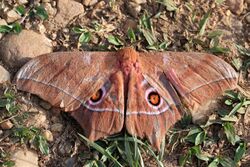Biology:Imbrasia epimethea
| Imbrasia epimethea | |
|---|---|

| |

| |
| In Uganda | |
| Scientific classification | |
| Domain: | Eukaryota |
| Kingdom: | Animalia |
| Phylum: | Arthropoda |
| Class: | Insecta |
| Order: | Lepidoptera |
| Family: | Saturniidae |
| Genus: | Imbrasia |
| Species: | I. epimethea
|
| Binomial name | |
| Imbrasia epimethea (Drury, 1773)
| |
| Synonyms | |
| |
Imbrasia epimethea is a species of moth belonging to the family Saturniidae. It was first described by Dru Drury in 1773 from the Calabar coast.
Description
Upper side: antennae strongly pectinated; the extremities appearing like threads. Thorax light brown, tinged with red. Abdomen grey brown. Anterior wings light grey brown, tinged with red at the base; having a narrow dark-coloured bar verged with grey running from the anterior to the posterior edges, parallel and at a little distance from the external margin. Posterior wings grey brown, terminating behind in points like acute angles; a dark narrow bar, edged with white, crosses these wings from the upper corners to the abdominal edges, dividing them into two compartments; in the uppermost of which are placed two eyes, whose centres are yellow, surrounded with black irides edged with red, and which also are encircled with ash-coloured rings. Above these eyes the wings are dark-coloured, almost black; but next the body are of a reddish hue.
Under side: legs black. Thorax and abdomen same colour as on the upper side. Wings nearly the same colour as on the upper side; the bars being plain and distinct, but the eyes are not observable here.
Drury's text does not state the wingspan, but his figure shows it as 5 inches (127mm).[1]
Distribution
It is found in Angola, Cameroon, the Republic of Congo, the Democratic Republic of Congo (Bas Congo, Katanga, Orientale), Equatorial Guinea, Gabon, Ghana, Guinea, Guinea-Bissau, Ivory Coast, Kenya, Mozambique, Nigeria, Sierra Leone, Tanzania, Togo and Uganda.[2]
Biology
The larvae are highly gregarious[3] and feed on Theobroma cacao, Petersianthus africanus, Petersianthus macrocarpus, Holarrhena floribunda, Funtumia species (including Funtumia africana and Funtumia elastica), Ricinodendron heudelotii, Acacia lahai, Terminalia, Bauhinia and Anona senegalensis.
Subspecies
- Imbrasia epimethea epimethea
- Imbrasia epimethea biokoensis Darge, 1988
References
- ↑ Drury, Dru (1837). Westwood, John. ed. Illustrations of Exotic Entomology. 2. p. 24. pl. XIII..
- ↑ "AfroMoths". http://www.afromoths.net/species_by_code/IMBREPIM.
- ↑ Latham, Paul (2003). Edible caterpillars and their food plants in Bas-Congo (First ed.). Mystole. pp. 20,21. ISBN 0954301277.
Wikidata ☰ Q1932121 entry
 |

